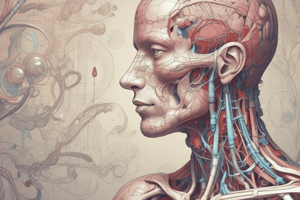Podcast
Questions and Answers
Define anatomy and physiology.
Define anatomy and physiology.
Anatomy is the study of the structures of the body, while physiology is the study of the processes and functions of the body.
Which of the following is NOT one of the levels of organization in the human body?
Which of the following is NOT one of the levels of organization in the human body?
- Cellular Level
- Chemical Level
- Organ System Level
- Energy Level (correct)
Anatomy is the study of the structures of the body, while __________ is the study of the processes and functions of the body.
Anatomy is the study of the structures of the body, while __________ is the study of the processes and functions of the body.
physiology
Negative feedback mechanisms turn off the original stimulus.
Negative feedback mechanisms turn off the original stimulus.
Flashcards are hidden until you start studying
Study Notes
Objectives
- Define anatomy and describe the levels at which it can be studied.
- Explain the importance of the relationship between structure and function.
Anatomy and Physiology
- Anatomy is the study of the structures of the body.
- Physiology is the study of the processes and functions of the body.
- Systemic anatomy studies the body by organ systems.
- Regional anatomy studies the body by areas.
- Surface anatomy uses superficial structures to locate deeper structures.
Structural and Functional Organization
- There are six levels of organization:
- Chemical level: atoms combine to form molecules.
- Cell level: molecules form organelles, which make up cells.
- Tissue level: similar cells and surrounding materials make up tissues.
- Organ level: different tissues combine to form organs.
- Organ system level: organs make up an organ system.
- Organism level: organ systems make up an organism.
Characteristics of Life
- Organization: all parts of an organism interact to perform specific functions.
- Metabolism: the chemical and physical changes taking place in an organism.
- Responsiveness: adjustments that maintain the internal environment.
- Growth: increase in size of all or part of the organism.
- Development: changes an organism undergoes through time.
- Reproduction: formation of new cells or new organisms.
Homeostasis
- Maintenance of a relatively constant internal environment.
- Set point is the ideal normal value (e.g., body temperature).
- Normal range is the fluctuation around set point.
- Homeostasis is maintained by negative and positive feedback mechanisms.
- Negative feedback turns off the original stimulus.
- Positive feedback enhances and up-regulates the initial stimulus.
Terminology and Body Plan
- Body positions:
- Anatomical position: human standing erect with face directed forward.
- Supine: person laying face up.
- Prone: person laying face down.
- Directional terms:
- Always refer to anatomical position.
- Right, ventral, left, dorsal, superior, proximal, inferior, distal, cephalic, lateral, medial, anterior, posterior, superficial, and deep.
Body Parts and Regions
- Body planes:
- Sagittal plane: divides the body into left and right parts.
- Transverse plane: divides the body into superior and inferior parts.
- Frontal (coronal) plane: divides the body into anterior and posterior parts.
Organ Planes
- Longitudinal section: along the long axis.
- Cross (transverse) section: right angle to the long axis.
- Oblique section: across the long axis at an angle other than a right angle.
Body Cavities
- Thoracic cavity: bounded by the ribs and the diaphragm.
- Abdominal cavity: bounded by the diaphragm and the abdominal muscles.
- Pelvic cavity: surrounded by the pelvic bones.
Serous Membranes
- Parietal membrane: lines the wall of the cavity.
- Visceral membrane: is in contact with the internal organs.
- Serous fluid: secreted by the serous membrane and protects organs against friction.
- Pericardial cavity: surrounds the heart.
- Pleural cavities: surround the lungs.
- Peritoneal cavity: surrounds certain abdominal and pelvic organs.
- Mesenteries: hold the abdominal organs in place and provide a passageway for blood vessels and nerves to organs.
- Retroperitoneal organs: located “behind” the parietal peritoneum.
Studying That Suits You
Use AI to generate personalized quizzes and flashcards to suit your learning preferences.




